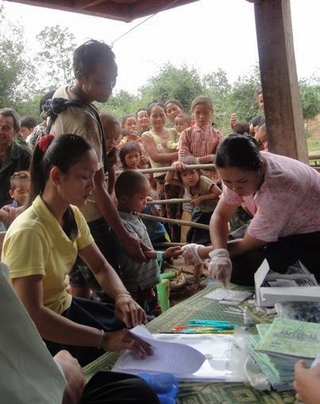November 28, 2012
Hitachi, RIHN and Nagasaki University Demonstrates Finger-Vein Authentication Technology in Laos for Tropical Disease Study
Keywords: Environmental Technology Manufacturing industry University / Research institute

Copyright Research Institute for Humanity and Nature
Hitachi Ltd., a leading general electronics manufacturer in Japan, announced on July 19, 2012, that it has carried out in the Lao People's Democratic Republic a field trial for a finger-vein authentication device, a type of biometric authentication technology to be used in a field study to investigate relationships between forest environmental changes and malaria infection. The field study is a part of the Ecohealth Project of the Research Institute for Humanity and Nature (RIHN), a part of the Inter-University Research Institute Corporation, National Institutes for the Humanities, Japan, in collaboration with the Institute of Tropical Medicine, Nagasaki University and Hitachi Ltd. The field trial is going to be conducted from July 19 through August 11, 2012, in the district of Sepone in Laos's southern province of Savannakhet, targeting about 3,500 residents aged six and older.
Researchers in the project have tried to register residents and follow their movements using a Health and Demographic Surveillance System, but have encountered difficulties in verifying personal identity, an essential part a successful long-term investigation. In the districts under investigation, residents can use multiple names and residential addresses. The need for biometric identification has led researchers to conduct a field trial for identification of people using Hitachi's finger-vein authentication technology.
Based on the results of the field trial, researchers will consider using the biometric system for future disease prevention activities, namely the management of various records such as vaccination records, the provision of mosquito nets to prevent malaria, and records linked to hospital information in the district where the verification test was conducted. They also hope to contribute to a richer collection of information on the Laos people.
Related
"JFS Newsletter"
Related
"Popular Articles"
- New Nano-Bubble Technology May Help Dissolve Sludge and Improve Water Quality
- Japanese Firm Begins Development of Tidal Power Generation System
- Small Hydropower Generation System Developed for Use in Seawater, Weight Cut by Half
- Constructed Wetland Facility Established by Japanese University Purifies Livestock Farming Drainage
- Toyota CRDL Succeeds in World's First Artificial Photosynthesis Using only Water and CO2


